1998-11-30 last update, 1996-08-26 first day; Robert
Jasiek
Copyright: All rights of the author are preserved according to the
international law.
The New Ko Rules
Introduction
The New Ko Rules are a successor of the Ing 1991 ko
rules and furthermore explain them. They are an improvement, because they
abandon methodical flaws and use clear definitions and rules.
The New Ko Rules are the rule set that approximates the
Ing 1991 ko rules most closely. Therefore it is long and not easy to understand.
For a simple rule set of the prohibition rules class please refer to the
Basic Ko Rules.
Every published example referring to the Ing ko rules
has the same outcome under the New Ko Rules. Perception of the New Ko Rules
is eased by Examples 1 and Examples
2.
The New Ko Rules restrict repeatedly cyclical play. Furthermore
the rules simplify many difficult and several ko positions on the board
by simplifying move-sequences in them, so that they are treated like a
basic ko and prohibited board plays can be rather easily detected in actual
play.
The major methodical flaws of the Ing 1991 ko rules that
are abandoned in the New Ko Rules are as follows:
- no ensured game end
- cyclical dependency of removable strings, settlement
of life and death, ko rules, distinction of ko types
- dependency on the whole game tree (sometimes called "go
theory") and on the whole of life and death in particular
- non-existence of a practically reliable definition of
"ko string"
- lacking definitions of various terms
- equivocal terms
- exceptional rules for special shapes
Due to the flaws in the Ing ko rules it is natural that
the New Ko Rules give a slightly different analysis of ko positions. This
is the price for gained precision.
There is much scope for variation of definitions and rules,
so that still all examples are treated correctly as under Ing ko rules.
Especially allowed move-sequences in disturbing kos or for several kos
on the board could be defined in many ways. I have used a variation that
approaches my knowledge of Ing ko rules as far as possible and that is
not logically contradictionary. Unreasonable features of the Ing ko rules
have been abandoned. The borders for sets of rules with ko type definitions
as to satisfactionary interpretation of any position are illustrated by
borderline examples for the New Ko Rules. Similar looking examples have
different ko types. The Ing ko rules try to avoid this problem by not using
unequivocal definitions.
To appreciate the New Ko Rules the reader should be aware
of the great variety of board positions including ko positions.
Abstract of the New Ko Rules: The reader should
be familiar with board play and pass play and start by understanding the
fundamental definitions like ko mouth. Ko positions may have a ko coupling
or not and correspondingly consist of several or only one ko mouths. Many
ko positions vary their state between stable and instable. A distinction
between fighting ko and disturbing ko is necessary for the rules. The four
rules are basic ko, fighting, disturber, and prohibition. Any go player
already has an intuitive knowledge about basic ko. The fighting rule dispenses
with so called hot stones. The disturber rule restricts repeatedly cyclical
play within one disturbing ko. The prohibition rule does the same for several
ko positions on the board.
Definitions for Ko
ko mouth
A ko mouth consists of the marked board points in any of the following
shapes, in any equivalent shape, in any equivalent shape with reversed
colours, or in any such shape of which a part or parts - but not any marked
board point - are cut off by at least one edge of the board. In any shape
diagram not marked empty points may be of empty, black, or white colour
as long as no illegal position arises.








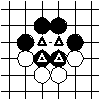
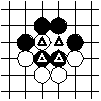

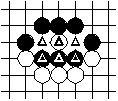

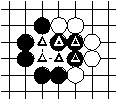
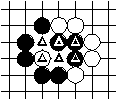
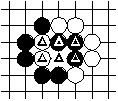
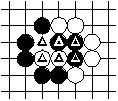
Notes:
- A shape can be equivalent due to dislocation or symmetries.
- Currently no other reasonable ko mouth shapes are known.
Their non-existence is an open problem.
- Perfect play need not always treat ko mouth shapes as
ko mouths in practice. However, to make shapes independent of perfect play,
it is not considered at all in the definition. This may have some awkward
consequences in practice, but since these rules' intention is a best approximation
to Ing ko rules, these troubles cannot be completely avoided. They are
not caused by insufficient aproximation but rather by the insufficiency
of the original approximated rules.
- The aim of the definition is not elegance. It shall serve
as a means of allowing understanding of the rules, which presuppose some
definition.
- I do not know the Chinese language but suspect due to
translated texts that in Chinese a tiger mouth denotes only half of a ko
mouth.
- A board point can be part of more than one ko mouth.
Hereby it is even possible that respective ko mouths have ko stones of
different colour. Also a single ko mouth can have ko stones of different
colour.
ko string
A ko string is a string in a ko mouth.
Notes:
- Some unreasonable ko strings are suitably dealt with
the prohibition rule.
- A ko string of 1/2/3 stones is also called single/double/triple
ko stones. Triple ko stones may or may not occur in a row.
ko stone
A ko stone is a stone of a ko string.
Note: A normal string shall be a string that is no ko
string.
move-sequence
A move-sequence is a non-empty colour-alternating sequence of board
plays or pass plays by both players.
ko stone move-sequence
A ko stone move-sequence is a move-sequence of board plays so that
only ko stones are played.
ko coupling
Given a ko mouth and its adjacent strings. All of at least two ko
mouths with all of the strings and none else being adjacent to each of
the ko mouths have them as their ko coupling.
Notes:
- All strings are normal strings.
- There are strings of different colour.
- Due to topological reasons of the plain no ko coupling
with at least three strings and at least three ko mouths exists.
- One might define ko space, i. e. a maximal connected
subboard so that some ko stone move sequence would include play of stones
on all its points. Then definitions of ko coupling and for ko types could
be extended considerably. Then the rules would take into consideration
a greater variety of shapes. But then the ruletext would be extremely long.
Currently it is rather short. This, of course, cannot be compared to super
ko. The aim of the New Ko Rules should not be to consider any possible
shape, but to assure an easy determination of allowed moves. Anything else
falls back into traditionalism.
- Similarly ko positions are not extended to environments
of ko couplings and environments of environments of unions of ko couplings
and ko spaces. This, however, seems to be a characteristic of Ing ko rules.
ko position
If a ko mouth is adjacent to all strings of a ko coupling and not
adjacent to any other string, then the ko position of the ko mouth is the
union of the board points of all ko mouths that are adjacent to all strings
of the ko coupling and not adjacent to any other string. If a ko mouth
is not adjacent to all strings of a ko coupling or adjacent to another
string, then the board points of the ko mouth are its ko position.
Note: Any ko position may remain on the board til the
end of the game. Thus no theoretical problem can arise as to a way of dissolution
of a ko position. Filling in is still possible. The Ing ko rules differently
require each ko position to have a so called outcome.
Definitions of Ko Types
stable disturbing life
A ko position of a ko coupling is in a state of stable disturbing
life if
- all strings of the ko coupling have at least two breaths,
- no move of one player can reduce the breath number of at least one
of the other player's strings of the ko coupling to one so that the other
player has without repeating the board position no possibility to regain
another breath for each of the affected strings immediately, and
- no ko stone move exists that is adjacent to a ko string of the opposing
colour, not adjacent to a ko stone of the own colour, and reduces the breath
number of at least one of the other player's strings of the ko coupling
to one.
Notes:
- The first point is a general feature of stable disturbing
life.
- The second feature ensures an interchange of breaths
between the strings of the ko coupling. An immediate recapture in a ko
mouth of two board points shall be no interchange.
- The third point is a necessary exception due to special
features of block-of-4 ko mouths.
instable disturbing life
A ko position of a ko coupling is a state of instable disturbing
life if the ko position is not in a state of stable disturbing life and
a ko stone move in the ko position exists that transforms the ko position
into a state of stable disturbing life.
Notes:
- A string of the ko coupling of one colour is temporarily
reduced to one breath.
- For transformation it is to be a ko stone move in the
ko position, so that approaching by taking a breath in another ko position
adjacent to the ko coupling is possible.
single disturbing life
A ko position which is not adjacent to all strings of a ko coupling
or is adjacent to another string is a single disturbing life if - with
each adjacent string to the ko position having as an assumption at least
one breath not in the ko mouth - on it a ko stone move-sequence of infinite
length could not be played or if it is a ko mouth that consists of 4 board
points in a row and has not had on it two ko strings after a move.
Notes:
- Finite ko stone move-sequences are a general feature
of single disturbing lifes. A ko mouth of 4 board points in a row has special
characteristics.
- In the case of a ko mouth of 4 board points in a row
if neither player is interested in playing a ko stone in the mouth, so
that after the move two ko strings in the ko mouth remain, then an infinite
move-sequence on it will never be played.
disturbing life
A ko position that is in one of the states stable disturbing life
or instable disturbing life or that is a single disturbing life is a disturbing
life.
stable disturbing death
A ko position of a ko coupling is a state of stable disturbing death
if
- the ko position consists of exactly two ko mouths,
- the ko mouths of the ko position have exactly two board points each,
- the ko position has a ko stone of each colour,
- at least one string of one colour of the ko coupling has exactly
one breath, and
- all strings of the other colour of the ko coupling have at least
two breaths.
Notes:
- The conditions describe a string of the ko coupling of
one colour as being on the verge of removal.
- Stable disturbing death cannot be instable disturbing
life.
instable disturbing death
A ko position of a ko coupling is a state of instable disturbing
death if
- the ko position is not in a state of stable disturbing life,
- the ko position consists of exactly two ko mouths,
- the ko mouths of the ko position have exactly two board points each,
and
- at least one string of the ko coupling, but all of one colour, has
exactly the breaths of the ko position as its breaths
Note: The strings of the ko coupling, that have the breaths
of the ko position, are called dead in disturbing death. They temporarily
seem to escape removal.
single disturbing death
A ko position consisting of exactly two board points is a single
disturbing death if in the cases of a ko stone of one respectively the
other colour in the ko mouth all adjacent strings to the ko stone could
have after a move of the player of these strings at least two breaths respectively
at most one breath provided that the move would neither capture the ko
stone nor reduce the breaths of at least one of these strings.
Notes:
- The adjacent strings to the ko mouth of one colour waver
between being on the verge of immediate removal and a postponement.
- An adjacent string with zero breaths would be captured
and thus cannot gain further breaths.
disturbing death
A ko position is a disturbing death if it is a single disturbing
death or in one of the states stable disturbing death or instable disturbing
death.
disturbing ko
Disturbing life or disturbing death.
Note: A distinction of disturbing life and disturbing
death generally ensures in a disturbing life ko threats for both players
and in a disturbing death a problem-free removal of so called dead strings.
fighting ko
A fighting ko is a ko position that is no disturbing ko.
Notes:
- Since fighting kos are no disturbing kos, fighting kos
like eternal life or triple ko, that are not basic kos, can be fought over
like basic kos.
- A distinction of fighting kos and the prohibition rule
ensure, that even with several ko positions on the board a fighting ko
is worth fighting.
disturbing a disturbing ko
A player is disturbing a disturbing ko if
- he plays a ko stone in a ko position that is in a state of a stable
disturbing life and reduces the breath number of at least one string of
the opponent unless the ko stone is adjacent to triple ko stones and not
adjacent to a ko stone of its colour,
- he adds a ko stone to a single ko stone in a single disturbing life,
- he has at least one string that has exactly one breath of the ko
coupling of a ko position that is in a state of stable disturbing death
and plays a ko stone in the ko position, or
- he plays a ko stone in a single disturbing death and could not have
played any other move that would have provided all his strings that are
adjacent to the ko mouth with at least two breaths.
Notes:
- In the case of stable disturbing life a played ko stone
may lead to instable disturbing life. Even if no transformation of state
takes place, the players might continue playing in the ko position, which
also must be restricted.
- In the case of stable disturbing life a triple ko stones
mouth has special features: A player is always compelled to prohibit two
eyes within a prior ko mouth.
- In each single disturbing life a double ko stone may
appear. So it is natural to use this general feature for restriction. It
would be superfluous to add further restrictions.
- Only the owner of the so called dead strings can be called
to be disturbing a disturbing death.
- A distinction of ko positions with respectively without
a ko coupling and of the states stable and instable ensures a reasonable
definiton of disturbing for a useful application of the disturber rule
in all disturbing kos.
Rules
Basic Ko
A single ko stone that has captured a single ko stone may not be
recaptured immediately.
Note: A recapture must be preceded by at least one board
play or pass play of at least one player.
Fighting
If in a fighting ko a ko stone is played, then the opponent's next
move may not play a ko stone in it.
Notes:
- If before the ko stone move the fighting ko, that exists
after it, has not existed yet, then the rule does not apply.
- If after the ko stone move the ko position of the fighting
ko does not exist or is no fighting ko any more, then the rule does not
apply.
- If a ko position looses its status fighting ko, still
all other rules might apply.
- To get rid of traditionalism, the two exceptions of the
Ing ko rules, eternal life and triple ko with double ko stones, have been
abandoned. Under Ing ko rules in eternal life only added ko stones are
important; this ensures an immediate removal of an adjacent string to the
ko mouth when winning the ko. Under Ing ko rules in triple ko with double
ko stones the opponent must not capture a ko string in the ko position
if a single ko stone has captured a single ko stone or if a ko stone has
been added to a single ko stone and not two double ko stones of the added
colour are present, and a recycling in the double ko stones part of the
ko position is prohibited because of invariation.
Disturber
During a ko stone move-sequence in a disturbing ko a player becomes
the disturber of the disturbing ko by disturbing it first. As soon as the
ko position of the disturbing ko with the stones on it has been repeated
since the moment just before the occurance of the current disturber, he
is not allowed to disturb the disturbing ko. With the end of the ko stone
move-sequence in the disturbing ko a disturber ceases to exist. If the
disturber is not allowed to disturb the disturbing ko and the ko stone
move-sequence in the disturbing ko continues and leads to a disturbing
move by the other player, then the disturber ceases to exist and the other
player becomes the disturber.
Notes:
- Only one player can be disturber at the same time.
- The rule is weak, but enforces finite move-sequences
in each disturbing ko, that might be called cycles or half-cycles.
- In the case of disturbing kos with a ko coupling a rule
could shorten allowed move-sequences to reappearance of stability, but
then that extra rule would be needed.
- Before prohibition for the disturber one move possibly
may repeat the ko position.
- A repetition of the ko position of the disturbing ko
with the stones on it need not be a repetition of the ko position just
before the occurance of the current disturber.
- Before a player gets a chance to play a disturbing move
in a ko stone move-sequence in a disturbing ko and to become the disturber
there might be a prologue of one move, that creates stability according
to the type of disturbing ko.
- Becoming disturber is restricted by the prohibition rule.
- A ko stone move-sequence also ends being in a distinct
disturbing ko, if it looses its status disturbing ko.
- A ko position changing between disturbing life and disturbing
death or between stable and instable still is the same ko position.
- Only in rare cases two disturbers one after another may
occur during one ko stone move-sequence in one disturbing ko. No decidedly
reasonable example is known yet.
Prohibition
From all board positions with the same set of board points of all
ko positions and with the same configuration of stones on the board without
the set each player may only once play a ko stone in each fighting ko,
become disturber of each disturbing ko, or otherwise play a stone on each
board point. As an exception for all such board positions the first played
ko stone in a fighting ko is ignored.
Notes:
- The rule evaluates two subsets of the board: All ko positions
and the rest of the board.
- For the rest of the board positional repetition must
not be of cyclical character: As soon as a repetition occurs the next board
play must not lead to repetition again. This is the same principle as with
super ko, however, super ko already forbids any occurance of a repeated
board position. The prohibition rule applies one move later.
- If the rule applies for a board position, then a distinct
player is not allowed to repeat one of his actions. Actions are a) playing
a ko stone in a fighting ko, b) becoming disturber of a disturbing ko,
c) playing a stone that does not invoke (a) or (b) on a board point. Respective
restrictions are limited to a) a distinct fighting ko, b) a distinct disturbing
ko, c) a distinct board point. Each player has his own restrictions.
- For all ko stone moves the detection of allowed moves
is much simpler than with a check of board position repetiton. The prohibition
rule limits the analysis during a move-sequence of ko stones and pass plays
to the union of all ko positions.
- While the rules of basic ko, fighting, and disturber
restrict play during ko stone move-sequences within one ko position, the
prohibition rule enforces restricted play in more than one ko position
and for the whole board.
- Unfortunately it is not possible to forget the whole
board position completely. In molasses ko repetition occurs without a ko
stone move-sequence. Other examples are unreasonable suicides, especially
when combined with pass plays.
- Even during a ko stone move-sequence that repeats the
configuration of the stones on the union of all board points that are not
part of a ko position the set of board points of ko positions can vary.
(Example: Triple ko stones in the Ing rules booklet 1991, C3-C4.)
- Under the same circumstances the exception of the rule
guarantees the player that is the first to have played a ko stone in a
fighting ko to play again a ko stone in that fighting ko once. This resembles
the one possible repetiton of a board position according to the disturber
rule.
- The exception reasonably ensures fights for fighting
kos.
- In general fighting kos are treated like basic kos.
- Answered ko threats may cause play of several moves within
a ko position until the rules of basic ko or disturber apply.
- In comparison to super ko, play in ko positions is reduced
to its qualitative essence and instead of generally keeping track of whole
board positions knowledge about board points of ko positions and played
ko threats is sufficient. Super ko analizes variation of board positions,
the new ko rules of ko threats.
- After a ko threat on the board that is not played in
a ko position, all ko threats in ko positions become available again. Variation
has still proceeded.
- The players need not play long ko stone move-sequences
with ko threats that cancel out each other but they might.
- The rule ensures a finite game end for moves in fighting
kos, disturbing kos, and on the rest of the board.
- In a disturbing life a first player might become the
disturber, then cease to be disturber, then generally after a pass play
the second possibly could become the disturber, but when he ceases, a play
on the rest of the board is necessary for another disturber in the ko position.
- Suicide of a single stone is prohibited by a move rule
rather than the prohibition rule. Ing rules speak of invariation here.
Acknowledgement
I would like to thank all persons who have verbally or
in writing discussed go rules. Without their - including many of you -
great efforts this page would not have been possible.
Links

















